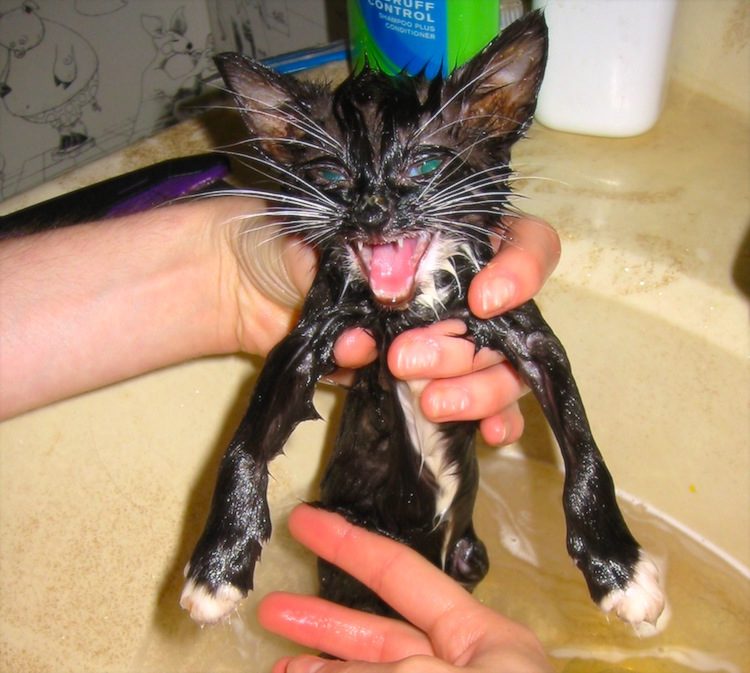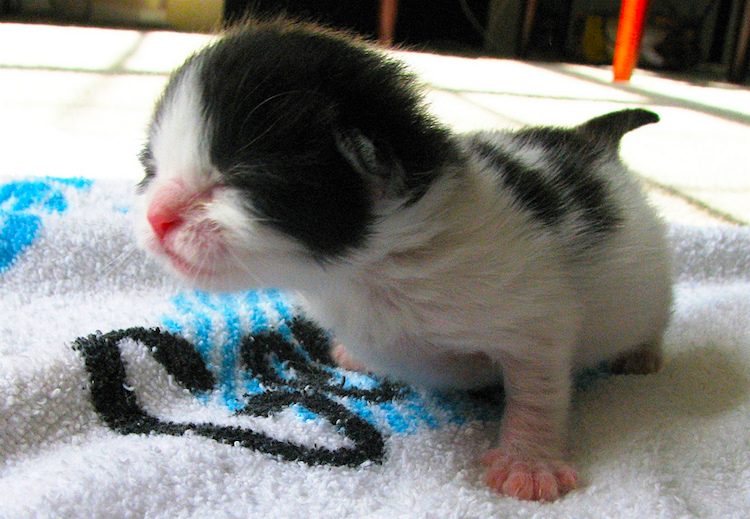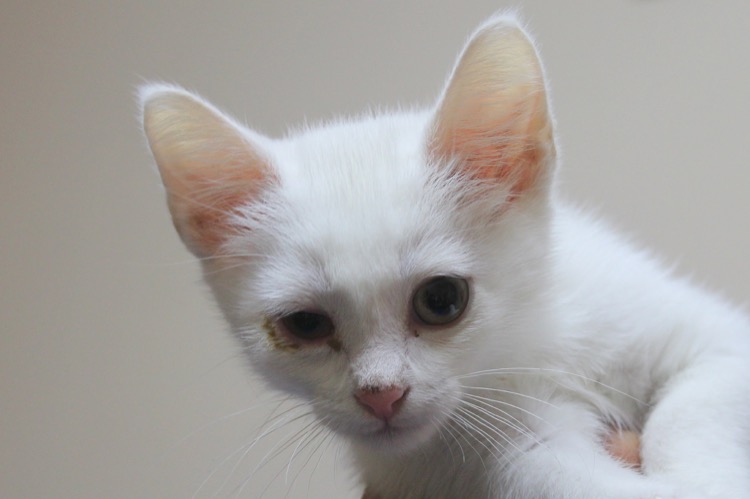Effective Kitten Flea Treatment: How to Safely Remove Fleas from Your Kitten
The dreaded little insects have invaded your kitten! Before you reach for any flea medicine for kittens, read these instructions.
This pet health content was reviewed for accuracy by a veterinarian, Dr. Pippa Elliott, BVMS, MRCVS. This article was originally published in 2012 and is regularly updated. It was last reviewed for accuracy and updated on September 3, 2024
If you have questions or concerns, call your vet, who is best equipped to ensure the health and well-being of your pet. This article is for informational purposes only and is not a substitute for professional medical advice, diagnosis, or treatment. See additional information.

- The Shocking Discovery of Fleas on Your Kitten
- How Fleas Find Their Way to Your Kitten
- The Worst Thing You Can Do: Nothing
- How to Safely Remove Fleas From Kittens
- Preventing Flea Infestations in Multi-Pet Households
- What About Flea Medicine for Kittens?
- Comparing Different Types of Flea Treatments for Kittens
- Staying Vigilant After Initial Kitten Flea Treatment
- Frequently Asked Questions (FAQ)
- References

Don’t leave your pet’s food safety to chance
Sign up for Petful recall alerts today.

The Shocking Discovery of Fleas on Your Kitten
There aren’t many things cuter than a kitten, but imagine your shock when playing with your new pet and finding fleas. These little bloodsucking, flightless insects can cause major problems for kittens and need to be removed immediately.
How Fleas Find Their Way to Your Kitten
Fleas can find their way to a kitten in various ways, even if the kitten is strictly an indoor-only cat:
- The mom cat may have fleas.
- Other pets may have brought in fleas.
- Sand tracked indoors can even contain fleas. Learn more about how indoor cats get fleas.
The Importance of Immediate Kitten Flea Treatment
As soon as you notice fleas either in the house or on a pet, it’s crucial to take action immediately:
- Start with a thorough inspection of your kitten and other pets.
- Begin the kitten flea treatment process as recommended by your vet.
- Find the best way to treat fleas as recommended by veterinarians.
The Worst Thing You Can Do: Nothing
Ignoring a flea infestation can have severe consequences, especially for kittens. Fleas can cause anemia in kittens, which can be deadly if left untreated.
“A flea doesn’t actually bite,” explains Dr. William Miller Jr., VMD. “It sticks its proboscis into the skin and sucks blood. It doesn’t take too much of this sucking to cause anemia in a kitten that is carrying innumerable fleas. You don’t see this problem very often in adult cats, but it’s frequently seen in kittens.”
Learn more about flea-related anemia in kittens.
Signs to Watch for in Kitten Flea Treatment
- Check your kitten’s gums: Ensure they are pink. Pale gums could indicate anemia, which is a medical emergency. If you notice any discoloration, bring your kitten to the veterinarian immediately.
- Monitor for excessive scratching and skin irritation: Fleas on kittens can cause severe discomfort, leading to constant scratching and skin issues.
- Follow veterinary advice: Kittens are especially delicate, and some flea treatments are not safe. Always consult your vet before administering any flea treatment.
Safe Kitten Flea Treatment for Newborns
- Treat the mother first: If you are dealing with a newborn kitten, start by treating the mother cat for fleas.
- Manual flea removal: Due to the young age and fragility of newborn kittens, avoid using any medications. Instead, remove fleas manually using your fingers or tweezers.
Dr. William Miller Jr. provides further insights into flea infestations in kittens and their impact on health.
Read more from Dr. Miller here.

How to Safely Remove Fleas From Kittens
When it comes to effective kitten flea treatment, following a safe and gentle process is crucial. Here’s a step-by-step guide to help you remove fleas from your kitten:
Step 1: Dampen the Kitten’s Coat
- Use warm (not hot) water: Begin by gently dampening the kitten’s coat.
“Exercise caution when bathing the kitten, as baths can be traumatic to a kitten if done incorrectly,” advises Hannah Shaw, a seasoned kitten fosterer. Learn more from Hannah Shaw.
- Work quickly: Complete the bath in less than 2 minutes to avoid panicking or chilling the kitten.
- Watch for fleas: Fleas often move to the driest area of the kitten, typically the head and facial area. Use your fingers or tweezers to grab them and drop them into a cup of hot, soapy water.
Step 2: Comb Out the Fleas
- Use a fine-tooth flea comb: While the kitten’s fur is still damp, comb through it to remove fleas.
“I immediately grab my flea comb and look for flea dirt. That icky black stuff is actually flea poop,” explains Dusty Rainbolt in Kittens for Dummies. Read more in Kittens for Dummies.
- Dispose of fleas properly: Drop any fleas you find into the cup of hot, soapy water.
- Repeat daily: Continue this process daily until the fleas are gone.
Step 3: Towel Dry the Kitten
- Dry thoroughly: Immediately and completely dry the kitten with a towel.
- Keep the kitten warm: Place the kitten in a warm environment, such as a heating disk or baby blanket, to prevent chilling.
Step 4: Clean the Bedding and Environment
- Wash bedding and fabrics: Gather all bedding and fabrics the kitten has been in contact with and wash them in hot water.
- Vacuum thoroughly: Vacuum any areas the kitten has been, and ensure to treat any other kittens or the mother if they also have fleas.
“Treatment of the whole house is essential, including soft furnishings, carpet pile, gaps between floorboards, and other difficult-to-reach areas,” according to International Cat Care. Learn more about thorough flea treatment.
Preventing Flea Infestations in Multi-Pet Households
If you have a multi-pet household, preventing flea infestations is a critical aspect of any kitten flea treatment plan. Fleas can easily transfer from one pet to another, making it essential to treat all animals in the home, not just the kitten.
- Simultaneous treatment: Ensure that all pets receive flea treatment simultaneously to prevent fleas from spreading.
- Regular cleaning: Frequently wash all pet bedding, vacuum carpets, and clean furniture where your pets spend time to minimize flea eggs and larvae.
- Use flea preventatives: Consider using flea preventatives on all pets, such as monthly topical treatments or flea collars, to maintain a flea-free environment.
By following these steps, you can effectively manage and prevent flea infestations in a home with multiple pets, ensuring your kitten remains flea-free.
What About Flea Medicine for Kittens?
When considering kitten flea treatment, it’s crucial to be cautious, as medications for kittens must be carefully selected based on their age and weight. Here are some important considerations:
- Treating the mother or adult cat: There are flea medications readily available for treating the mother or adult cat. Learn more about the best flea treatments.
- Age and weight considerations: Medications for kittens are determined by age and can be deadly if used incorrectly. It’s essential to consult with your vet before applying any flea treatment. Learn about the dangers of inappropriate flea treatments.
Comparing Different Types of Flea Treatments for Kittens
When choosing the right flea treatment for your kitten, it’s important to understand the different types available. Kitten flea treatments generally come in three forms:
- Topical treatments: These are applied directly to the skin and are absorbed into the kitten’s bloodstream. Topical treatments are effective but should only be used on kittens that meet the minimum age and weight requirements.
- Oral medications: These are given by mouth and work internally to kill fleas. Some oral medications, like Capstar, can be used in kittens as young as 4 weeks old, but always consult your vet first.
- Flea collars: Flea collars release chemicals that kill fleas and can provide long-lasting protection. However, most flea collars are not recommended for very young kittens due to their sensitive skin.
Each type of kitten flea treatment has its pros and cons, so it’s essential to choose the one that best fits your kitten’s needs and age.
Safe Flea Treatment Guidelines for Kittens
- Manual removal for newborn kittens: Newborn kittens require manual flea removal since their young age and small size make them too fragile for flea medications.
- Kittens over 4 weeks old: In consultation with your vet, kittens over 4 weeks old may be treated with Capstar (note the minimum weight requirement). This medication kills adult fleas but not their offspring. Read more about Capstar.
- Kittens 8 weeks and older: Other flea medications safe for kittens generally list 8 weeks of age as a minimum requirement.
Natural Remedies vs. Medicated Flea Treatments for Kittens
When considering kitten flea treatment, many pet owners wonder whether natural remedies are a safer alternative to medicated treatments.
- Natural remedies: Options like apple cider vinegar, lemon spray, or diatomaceous earth are often suggested as natural flea repellents. However, these remedies may not be as effective or safe as they seem. It’s crucial to consult with your vet before using any natural flea treatment on your kitten.
- Medicated treatments: Medicated flea treatments, such as topical applications or oral medications, are scientifically tested for efficacy and safety. While these treatments are more effective at eliminating fleas, they must be used correctly, following the vet’s guidance.
In general, while natural remedies might sound appealing, medicated kitten flea treatments are usually the more reliable and safer choice, especially for very young or vulnerable kittens.
Avoid Unsafe Treatments
- Avoid natural or homeopathic treatments: These may harm your kitten, especially if not recommended by your vet. Understand the risks of natural supplement toxicity.
- Avoid essential oils: Essential oil treatments can be particularly dangerous for kittens. Learn more about the safety of essential oils for pets.
Here’s a video explaining more about treating a kitten for fleas:
Staying Vigilant After Initial Kitten Flea Treatment
Fleas are pesky, tiny insects, and multiple washings and cleanings may be necessary even after the initial kitten flea treatment. It’s not uncommon to spot a few remaining fleas after your first efforts.
Ongoing Flea Control
- Immediate action: Kill or remove any remaining fleas as soon as you see them.
- Regular checks: Keep checking your kitten regularly to ensure no more fleas return.
Transitioning to Adult Flea Treatments
As your kitten gets older, you will be able to switch to topical treatments that are suitable for adult cats. Until then, it’s important to stay vigilant and treat fleas on the spot to keep your kitten comfortable and healthy.
Frequently Asked Questions (FAQ)
How old does a kitten have to be to get flea treatment?
A kitten can typically receive flea treatment starting at 8 weeks old, depending on the product and weight requirements.
When can I use flea treatment on my kitten?
You can start using flea treatment on your kitten once they are 8 weeks old and meet the minimum weight requirements.
References
- “Fleas: A Source of Torment for Your Cat.” Cornell University College of Veterinary Medicine. 2016. https://www.vet.cornell.edu/departments-centers-and-institutes/cornell-feline-health-center/health-information/feline-health-topics/fleas-source-torment-your-cat.
- Shaw, Hannah. “Fleas.” 2018. http://www.kittenlady.org/fleas.
- “Safe Use of Flea and Tick Preventive Products.” American Veterinary Medical Association. https://www.avma.org/public/PetCare/Pages/Safe-use-of-flea-and-tick-preventive-products.aspx.
- Rainbolt, Dusty. Kittens for Dummies. John Wiley & Sons. 2019. 292. https://books.google.com/books?id=squkDwAAQBAJ&pg=PT292#v=onepage&q&f=false.
- “Best Flea Treatment for Kittens.” Pawlicy. https://www.pawlicy.com/blog/best-flea-treatment-for-kittens/
- “How to Get Rid of Fleas on Kittens.” PetMD. https://www.petmd.com/cat/parasites/how-get-rid-fleas-kittens








